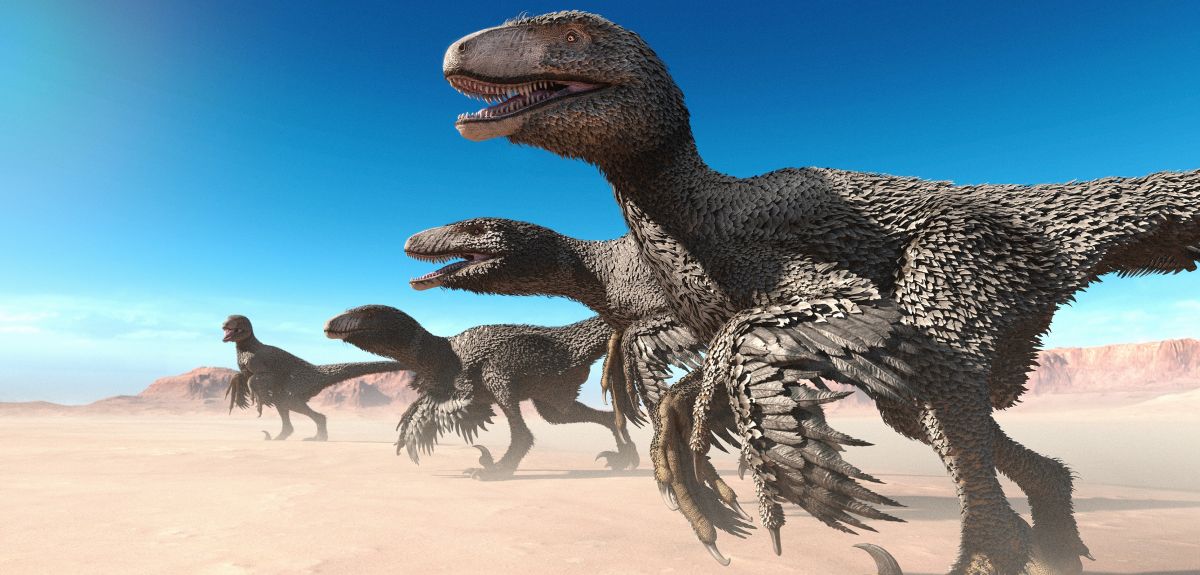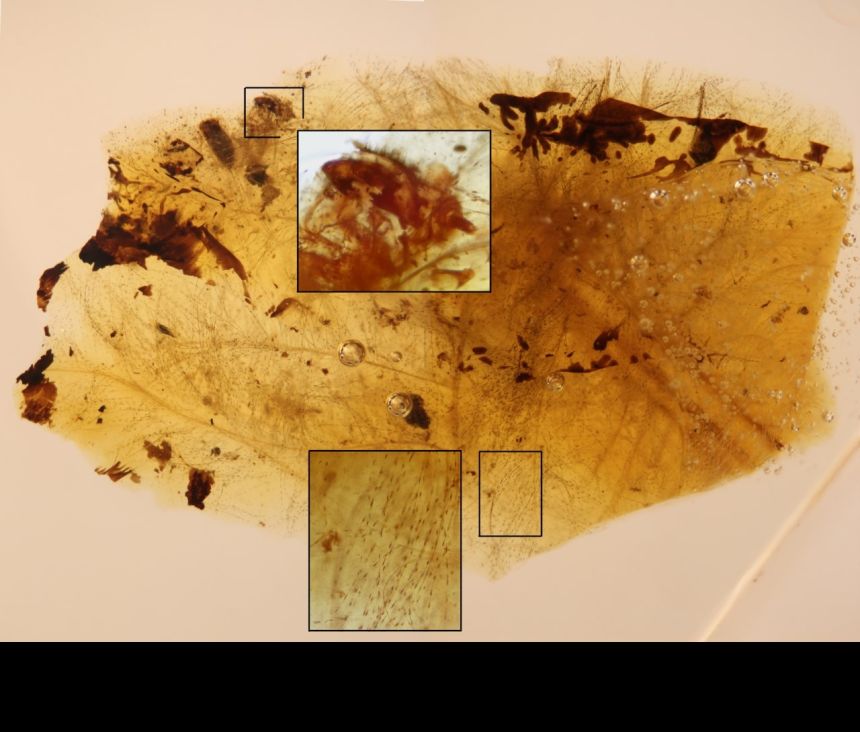
Fossils reveal a 100-million-year-old relationship between feathered dinosaurs and feather-feeding beetles
New fossils in amber reveal that beetles fed on the feathers of dinosaurs about 105 million years ago. The exquisite specimens show one of the best supported examples of a close interaction between vertebrates and arthropods in the fossil record. The study has been published in Proceedings of the National Academy of Sciences of the United States of America.
Our findings demonstrate that beetles and feathered theropods have interacted since the Mesozoic, and shed light on the evolutionary importance of early relationships between arthropods and vertebrates.
Dr Ricardo Pérez-de la Fuente, Oxford University Museum of Natural History
Analysis of spectacular fossil amber fragments, from the locality of San Just in north-eastern Spain, revealed moults of tiny beetle larvae tightly surrounded by portions of downy feathers. The feathers belonged to an unknown theropod dinosaur that lived around 105 million years ago, during the Early Cretaceous. This means that the feathers could not have come from a ‘modern bird’ species, since current evidence indicates that this group appeared about 30 million years later in the fossil record, during the Late Cretaceous.
The larval moults preserved in the amber were identified as related to modern skin beetles, or dermestids. Dermestid beetles are infamous pests of stored products or dried museum collections, feeding on organic materials that are hard for other organisms to digest such as natural fibres. However, dermestids also play a key role in recycling organic matter in the natural environment, and often inhabit the nests of birds and mammals, where feathers, hair, or skin, accumulate.
The feathers had almost certainly become detached from the host dinosaur, since they showed signs of damage and decay, including fungal strands growing on their surface. Consequently, the researchers propose that the beetle larvae probably lived in or on a dinosaur nest, where enough feathers could accumulate to sustain a population. This nest would have been on or close to a resin-producing tree, with the first step leading to the formation of the amber fossils happening when a flow of resin trapped the larvae and feathers, preserving them together for millions of years.
Similarly, modern bird and mammal nests are inhabited by diverse communities of insects and arachnids that feed on the rich –yet often highly specialised– sources of organic material, which include keratin in the form of feathers, hair, and skin, as well as faeces.
 Isolated moult of the feather-feeding beetle larva found in the Spanish amber outcrop of Rábago/El Soplao, with detail of its powerful mandibles (right). Length of the moult is less than two millimetres (Image credit: CN IGME-CSIC).
Isolated moult of the feather-feeding beetle larva found in the Spanish amber outcrop of Rábago/El Soplao, with detail of its powerful mandibles (right). Length of the moult is less than two millimetres (Image credit: CN IGME-CSIC). ‘It is unclear whether the feathered theropod host benefitted from the beetle larvae feeding on its detached feathers in this plausible nest setting,’ says Dr Ricardo Pérez-de la Fuente, from Oxford University Museum of Natural History (OUMNH) and co-lead author of the study. ‘However, the theropod was most likely unharmed by the activity of the larvae since our data indicate that these did not feed on "living" plumage. Furthermore, the larvae lacked defensive, bristle-like structures which among modern dermestids can irritate the skin of nest hosts, even killing them.’
Dr Pérez-de la Fuente’s research focuses on preservation in amber and fossil arthropods, particularly insects and arachnids dating from the Cretaceous. In this new research, his contribution included identifying the fossil insect species captured in the amber fragments.
‘The fossils puzzled us for a while, since they show some features that do not fall among the modern diversity of skin beetles’ he said. ‘Fortunately, working at OUMNH gives me access to one of the best entomological libraries in the world and more than five million pinned insect specimens in its collections, which can be used to match against fossils. I’m incredibly lucky to work with such privileged assets.’
 Moult remains of feather-feeding beetle larvae intimately associated with downy feather portions from an unidentified theropod dinosaur in Early Cretaceous amber of Spain. Insets show the head with powerful mandibles of one of the larval moults (top) and the pigmentation pattern of feather second order branches (bottom), with the main stem of one feather at the right of the amber fragment. The length of the amber fragment is 6 millimetres across. Image credit: CN IGME-CSIC.
Moult remains of feather-feeding beetle larvae intimately associated with downy feather portions from an unidentified theropod dinosaur in Early Cretaceous amber of Spain. Insets show the head with powerful mandibles of one of the larval moults (top) and the pigmentation pattern of feather second order branches (bottom), with the main stem of one feather at the right of the amber fragment. The length of the amber fragment is 6 millimetres across. Image credit: CN IGME-CSIC.Vertebrates and arthropods have coexisted for more than 500 million years, and their interactions throughout deep time are thought to have critically shaped their evolutionary history, often leading to coevolution. In modern ecosystems, examples of these diverse and complex ecological relationships include ticks infesting cattle, frogs capturing insects with acrobatic tongues, and barnacles growing on the skin of whales.
Nevertheless, direct evidence of arthropod-vertebrate relationships is extremely rare in the fossil record. The only previous instances had been of parasites, either chewing lice or blood-sucking ticks. But in this new study, the researchers believe that the theropod dinosaur was either unharmed by the beetles or may even have benefitted from the cleaning effect of the beetle feeding on its detached feathers.
‘The emerging view is that some groups of arthropod symbionts of feathered theropods in the late Mesozoic transitioned to modern birds in the Cenozoic, Earth's current geological era’ added Dr Pérez-de la Fuente. ‘I suspect that as more fossils are unearthed we will keep finding more key evidence on how two of the most prominent groups of animals, arthropods and vertebrates, have influenced each other’s fascinating, and often intertwined, evolutionary pathways.’
The paper ‘Symbiosis between Cretaceous dinosaurs and feather-feeding beetles’ has been published in the journal Proceedings of the National Academy of Sciences of the United States of America.
The study was co-led between the Geological and Mining Institute of Spain of the Spanish National Research Council (CN IGME-CSIC) and Oxford University Museum of Natural History (OUMNH).
 New Year Honours 2026
New Year Honours 2026
 New study estimates NHS England spends 3% of its primary and secondary care budget on the health impacts of temperature
New study estimates NHS England spends 3% of its primary and secondary care budget on the health impacts of temperature
 International collaboration launches largest-ever therapeutics trial for patients hospitalised with dengue
International collaboration launches largest-ever therapeutics trial for patients hospitalised with dengue
 Oxford-built multi-agent assistant for cancer care to be piloted in collaboration with Microsoft
Oxford-built multi-agent assistant for cancer care to be piloted in collaboration with Microsoft